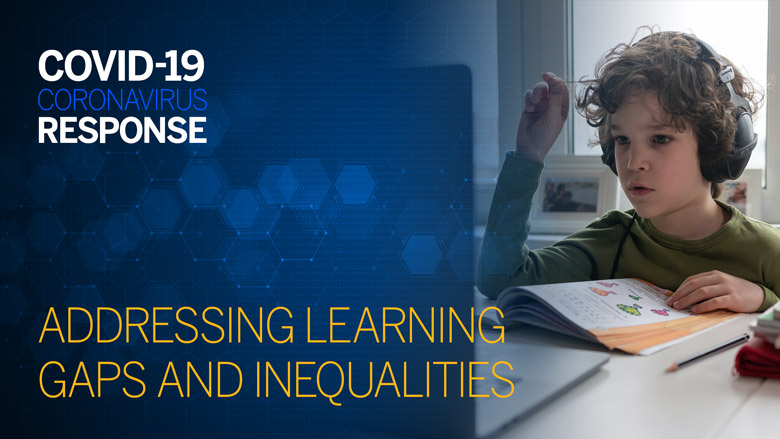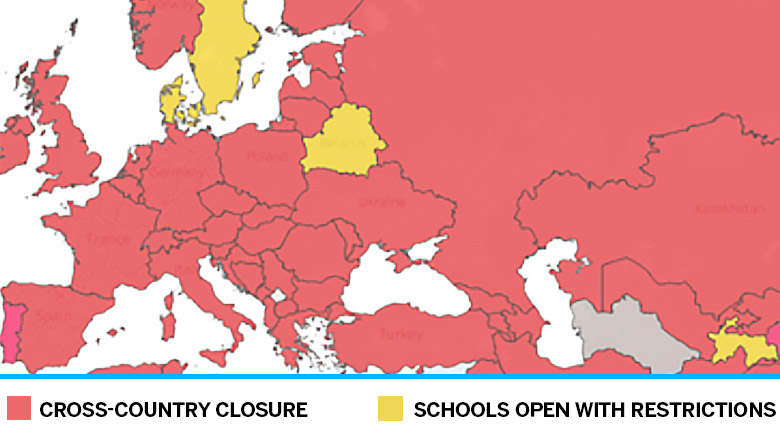
CHALLENGES
Social distancing poses risks to education. Schoolchildren are at home. Although some are learning through distance education, most children—and predominantly the poor—will suffer a loss of up to six months of learning. Due to the continued pandemic and/or this learning loss, school dropout rates might be significant. Despite widespread access to higher education, under-represented students are more likely to drop out during their tertiary education studies or to attain a lower level of qualification than their more privileged peers. The effects of COVID-19 may widen the gap of learning outcomes between the 104 million learners from high-income countries (HICs) and the 59 million in middle-income countries (MICs). A gap of 13 percent is noted between the average human capital index (HCI) of HICs and MICs.
Learning loss affects short- and long-term economic gains and human capital growth and also widens the equity gap in terms of student learning. The impact of the COVID-19 pandemic primarily affects public health, but spillover effects can already be observed in the education systems of many countries. The accumulated human capital—widely accepted as a major contributor to the wealth of nations—is at risk. COVID-19 is disrupting education practices from early childhood development (ECD) to tertiary education. A substantial number of issues will affect the education sector overall, including growing fear and uncertainty, psychological challenges (for children, teachers, and parents), and the very sustainability of private and public educational institutions due to the ongoing economic instability.
Increased income disparities due to the pandemic and the subsequent recession will likely depress skills development further (such as years of schooling, skills proficiency), particularly among individuals from low socioeconomic backgrounds.

WHAT RUSSIA HAS DONE TO CONFRONT THESE CHALLENGES
Expansion of online education legislation
The Russian Parliament is planning to introduce a package of directives that will update legislation on the distance learning format for all levels of education.
Closure of public kindergartens
Each Russian region has coordinated the closure of its public kindergartens differently. In some regions, kindergartens have kept only special groups (watch groups) open with a small number of children.
A move to online education and postponement of all school test dates
All educational institutions have organized distant learning for pupils. Russian IT companies are supporting the various online platforms, such as Russian online school, Yandex.textbook, Teach.ru, Yaklass, and Дневник.ру, that are available for teachers, students, and parents. Together with the website Mail.ru, the Ministry of Education regularly runs an online marathon “Home Hour” via the Vkontakte social network. The Ministry of Education has also launched a hotline to support regional ministries, schools, and colleges in organizing distance learning. On April 27, the ministry launched a TV program called “My School Online” that consists of online lessons and textbooks for secondary school pupils.
The Ministry of Education has shifted the dates of the all-Russian school tests to the end of the year.
A shift to remote tertiary education
The Russian government has provided operational support to educational organizations, students, and teachers to aid in the shift to mixed and distance learning formats. An additional week of vacation was granted to students from March 28 to April 5 so that universities could prepare for distance education. All of the universities reporting to the federal ministry (248) have transferred their educational operations to an online format. Several online resources have also been launched: a situation center and a hot line, a YouTube channel for online broadcasts of meetings and workshops, a Telegram channel @minobrnaukiofficial, and a website for universities (“Keep learning, Keep teaching”) with methodological support. An online platform established by the Agency of Strategic Initiatives, The University 2035, provides additional methodological support to universities.
The Ministry of Education is piloting a new service for school graduates so that they can apply to university programs online using the state portal Gosuslugi.
State accreditation will be prolonged for one year for those universities whose accreditation expires between March 2020 and December 2020.
More than 100 universities have provided jobs for students who have lost their income due to the pandemic. For instance, Tomsk University has announced 200 available positions for students. The Ministry of Education will support those universities that are organizing student employment programs.
WHAT ARE OTHER COUNTRIES DOING?
Selective closure of schools. Choosing to isolate treatment areas, some governments have opted for localized school closures as an interim measure (for example, India). In half of the cases thus far, these localized approaches have subsequently expanded geographically (Brazil, India, Canada, Australia).
National closure of schools (the most used option globally). As the virus has spread, many countries have announced national school closures. Many are concerned that children and youth, though seemingly less susceptible to the virus and having a much lower case-fatality ratio, may serve as carriers for the disease, putting at risk older family members in communities across the globe where multi-generational households are the norm.
Use of remote learning and education resources to mitigate the loss of learning. Many countries have turned to distance learning as a means of making up for lost time in school (fully online in China, Italy, France, Germany, and Saudi Arabia; mobile phones or television in Vietnam and Mongolia). In Bulgaria, more than 800,000 accounts have been created for all teachers and parents, publishers have been mobilized to open digital textbooks and learning materials for grades 1–10, and two national TV channels will broadcast educational television programs.
Promotion of ECD through a combination of cash transfers and parenting programs. Cash transfer programs, coupled with information and behavior change efforts to help parents support their children’s development, have yielded positive impacts in many countries, including increased preschool enrollment in Uganda and improved cognitive outcomes in Colombia and Mexico.
WHAT MORE COULD BE DONE?
Education provides an opportunity for governments, individuals, and families to continue building human capital, to protect the poor and vulnerable, and to kick-start the economic recovery while promoting sustainable economic growth and poverty reduction. Well-designed education policies should be at the cornerstone of the response to the crisis.
Make equity a priority. Provide integrated early childhood education and care (ECEC) services at scale, including for minority and vulnerable children (e.g., Roma, refugees, children with special educational needs) and their families. Provide information and technical support to the parents of young children. See, for example, the World Bank’s 15 Ways to Support Young Children and their Families in the COVID-19 Response.
Proceed with adapting school systems to remote learning without creating further inequities over the medium term.
- catalyze innovations in education, creating ways to learn at home through interactive apps, live television broadcasts, online classrooms, and teleconferences
- upgrade the information and communications technology (ICT) education infrastructure through solutions provided by public-private partnerships, including governments, education professionals, nongovernmental organizations, technology providers, and telecom network operators
- prioritize investments in vulnerable children through the targeted provision of ICT equipment to decrease the current digital divide between wealthy and poor people and urban and rural areas.
Governments and their partners must sustain education progress by prioritizing and investing in safeguards to ensure that all students stay engaged and continue learning to prevent further human capital loss. In this context, governments are best placed to pursue three objectives that will accelerate learning or learning recovery:
- Objective 1: continuity of learning (short term) – provide continuity in the supply of learning during the COVID 19 crisis or catch-up solutions, especially for low-income students at risk of dropping out
- Objective 2: adequate financing (short to medium term) – maintain adequate education funding to support targeted interventions, especially for students at risk of early school leaving
- Objective 3: build resilience (medium term) – ensure a resilient recovery and more robust education systems with increased capacity to provide distance learning and improved practices
Plan for a gradual reopening. ECD and school reopenings should be aligned, prioritizing the areas that would need to be accessed at the earliest opportunity and analyzing the precautions that should apply and could help speed up the process.
RISKS AND PITFALLS TO AVOID
- A strong focus on minorities or children from vulnerable groups should be made in the ECD area to avoid inequalities.
- Equal access to learning resources should be maintained, especially in deprived areas and regions.
- Disparities among Russian universities in their ability to provide distance learning to students and the necessary services to teachers should be mitigated (i.e., the differences between elite and struggling universities).
- Regular monitoring and feedback channels with teacher and parent communities should be established to help enhance the process of adaptation to distant learning and the gradual return to face-to-face formats.
Last Updated: May 07, 2020
MULTIMEDIA
Expert Answers: How Can We Help Countries Dealing with Coronavirus?
Experts
Renaud Seligmann
Director for Strategy and Operations, Planet Vice Presidency
